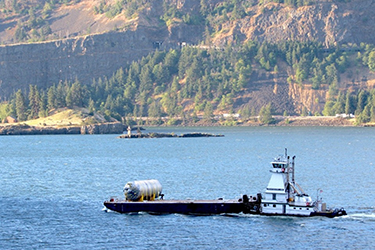|
Subscribe / Renew |
|
|
Contact Us |
|
| ► Subscribe to our Free Weekly Newsletter | |
| home | Welcome, sign in or click here to subscribe. | login |
Architecture & Engineering
| |
July 22, 2016
65-ton test tank heads up Columbia to Richland
If you were traveling along the Columbia River last week you may have seen a giant stainless steel tank on a barge heading from Vancouver to the Tri-Cities area.
Another brewery opening in Eastern Washington? Not this time. This tank, all 65 tons of it, will have a more serious task of mixing simulated radioactive waste to help researchers find the best method to dispose of 56 million gallons of real nuclear waste.
The tank was made by Greenberry Industrial, which is a subcontractor to Bechtel National, the company in charge of waste disposal at Hanford. The tank is 35 feet high, 16 feet in diameter and can hold 22,000 gallons. It will weigh 310 tons when filled.
Greenberry made the tank at its plants in Vancouver and Corvallis, Oregon.
The tank is a full-scale prototype for several vessels that are expected to be used to process liquid radioactive waste containing solids. It has pulse-jet mixers inside it that work like turkey basters — withdrawing fluid and expelling it — to mix the contents. The mixers use compressed air and have no moving parts.
Previous tests using a smaller vessel confirmed that control equipment can reliably operate the pulse-jet mixers. The new vessel will be used to test the equipment at full scale. It will be loaded into the Full-Scale Vessel Test Facility in nearby Richland through the roof and placed in a specially designed test stand.
Reassembling the test stand and completing preparations for testing will take several months. The year-long testing program is expected to begin later this year.
Past technical decisions curtailed or slowed construction on the 490,000-square-foot Pretreatment Facility that Bechtel is building as a component of the Vit Plant at Hanford. New testing is expected to clear that hurdle.
When complete, the Vit Plant will turn radioactive waste into glasslike logs for safe long-term disposal. The plant covers 65 acres and will have four primary buildings for waste disposal: Pretreatment, High-Level Waste Vitrification, Low-Activity Waste Vitrification and the Analytical Laboratory. There also will be operations and maintenance buildings, utilities and offices.
Waste will be pumped from Hanford's 177 aging underground tanks to the Pretreatment Facility, where it will be separated into high-level radioactive waste and low-activity radioactive waste. Next, silica will be added to both types of waste and the resulting mixtures will go through high-temperature melters to form molten glass.
Molten glass will be poured into containment vessels to cool into glass logs. High-level waste will go to a federal repository and low-activity waste will be buried in canisters at the Integrated Disposal Facility at Hanford.
A federal judge earlier this year set deadlines for the low-activity waste plant to begin operation by 2022 and the high-level waste plant by 2036.
A Bechtel representative wrote in an email that the lab building is 97 percent finished and work is continuing on the Low-Activity Waste Vitrification building and supporting facilities. He said construction was halted on the Pretreatment Facility and curtailed on the High-Level Waste Vitrification building in 2014 by the Department of Energy to resolve technical issues. A new schedule will be developed when the technical issues are resolved, he said.
Hanford for decades made plutonium for nuclear weapons and now is cleaning up of the nation's largest collection of radioactive waste. Many of the underground tanks that hold the waste are leaking.



